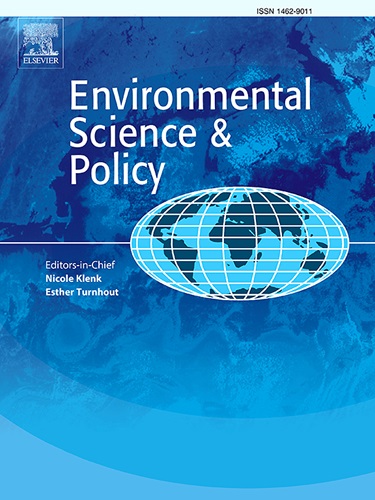A methodological framework for assessing the coherence of Water-Energy-Food-Ecosystem nexus policies: Illustration and application at the river basin level
IF 5.2
2区 环境科学与生态学
Q1 ENVIRONMENTAL SCIENCES
引用次数: 0
Abstract
The Water-Energy-Food-Ecosystem (WEFE) nexus emerged as an approach for efficient management of natural resources. WEFE nexus governance aims to ensure exploiting synergies and managing trade-offs arising from the WEFE nexus interlinkages. In this context, policy coherence is not only a critical component, but also an indicator of successful WEFE Nexus governance. Despite its importance to the nexus, there are few policy coherence assessment methods and policy coherence investigations into the WEFE nexus. The existing policy coherence assessment approaches fail to offer an assessment of the coherence in both policy documents and practical implementation of policies. Moreover, to understand policy coherence in practice, insights of local stakeholders are needed, which is often missing in the existing approaches. We propose a comprehensive policy coherence assessment framework (PCAF) that assesses policy coherence in both its formulation and implementation. Specifically, we adapt and combine the methods of Nilsson et al. (2016) and Mooren et al. (2024) and demonstrate its usefulness by applying it to the Nestos river basin in Greece. Our results show that shifting the focus from analyzing the net influence of policies on one another to identifying Nexus hotspots helps to effectively manage policy trade-offs and synergies by: 1) enabling the identification of policies requiring revision or strengthening; 2) providing insights into whether these hotspots have positive or negative cascading effects throughout the nexus; and 3) via stakeholder feedback on the policy coherence analysis, offering insights on policy implementation in practice.
评估水-能源-粮食-生态系统关系政策一致性的方法框架:在流域一级的说明和应用
水-能源-食物-生态系统(WEFE)关系作为一种有效管理自然资源的方法而出现。世界经济论坛联系治理旨在确保利用协同效应并管理世界经济论坛联系相互联系所产生的权衡。在这种情况下,政策一致性不仅是一个关键组成部分,而且是经济论坛Nexus治理成功的一个指标。尽管政策一致性对经济经济联系具有重要意义,但目前针对经济经济联系的政策一致性评估方法和政策一致性调查较少。现有的政策一致性评估方法未能对政策文件和政策实际执行的一致性进行评估。此外,为了理解实践中的政策一致性,需要了解当地利益相关者,而这在现有方法中往往是缺失的。我们提出了一个全面的政策一致性评估框架(PCAF),评估政策制定和实施的一致性。具体而言,我们调整并结合Nilsson等人(2016)和Mooren等人(2024)的方法,并通过将其应用于希腊Nestos河流域来证明其实用性。我们的研究结果表明,将重点从分析政策对彼此的净影响转移到识别Nexus热点,有助于有效地管理政策权衡和协同效应:1)能够识别需要修订或加强的政策;2)深入了解这些热点在整个联系中是否具有积极或消极的级联效应;3)通过利益相关者对政策一致性分析的反馈,为政策实施提供实践见解。
本文章由计算机程序翻译,如有差异,请以英文原文为准。
求助全文
约1分钟内获得全文
求助全文
来源期刊

Environmental Science & Policy
环境科学-环境科学
CiteScore
10.90
自引率
8.30%
发文量
332
审稿时长
68 days
期刊介绍:
Environmental Science & Policy promotes communication among government, business and industry, academia, and non-governmental organisations who are instrumental in the solution of environmental problems. It also seeks to advance interdisciplinary research of policy relevance on environmental issues such as climate change, biodiversity, environmental pollution and wastes, renewable and non-renewable natural resources, sustainability, and the interactions among these issues. The journal emphasises the linkages between these environmental issues and social and economic issues such as production, transport, consumption, growth, demographic changes, well-being, and health. However, the subject coverage will not be restricted to these issues and the introduction of new dimensions will be encouraged.
 求助内容:
求助内容: 应助结果提醒方式:
应助结果提醒方式:


